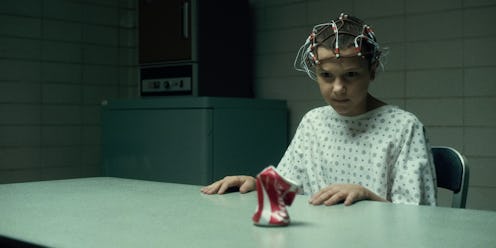
If you're making your way through watching Netflix's Stranger Things, you know that the mysterious series is so many things. It's a throwback teen drama. It's an eerie sci-fi-ish, supernatural adventure. It's a show that contains every '80s song you've ever loved. But it's also just straight out crazy sometimes, especially when that great soundtrack plays while scenes are set at Hawkins National Laboratory. While the show's music and the '80s are based in reality, whether Stranger Things' Hawkins National Laboratory is real is another story. Since the series takes place in the fictional town of Hawkins, Indiana, there isn't, in fact, a real creepy experiment-filled lab like Hawkins (that the public knows of, anyway).
According to Variety, Stranger Things' original title was Montauk , because the show was supposed to be set in Montauk, Long Island, in New York. Why the Eastern tip of Long Island? "We were excited about the idea of doing something coastal. Probably our favorite movie of all time is Jaws, and Montauk is one of the bases for Amity, so I think that’s where that idea came from," co-creator Ross Duffer told The A.V. Club in an interview.
And, though the creators did not state this as a source of inspiration, unsubstantiated conspiracy theories claim that Montauk was supposedly the setting of government experiments in the 1980s. A book called The Montauk Project: Experiments in Time by Peter Moon and Preston Nichols alleged that experiments took place at the (now decommissioned) Montauk Air Force Base and dealt with time travel. Duffer, meanwhile, told The A.V. Club that he and his brother "really love conspiracy theories" and figured a small-town setting would make a plotline like that "more believable."
So while Hawkins National Laboratory may be fictional in your nightmares, the eerie place still has roots in several unsubstantiated conspiracy theories that claim to involve places such as:
Camp Hero At The Montauk Air Force Base
According to The Huffington Post, a documentary film called The Montauk Chronicles called upon those unsubstantiated conspiracy theories to allege that Camp Hero was at one point used for secret government experiments that dealt with aliens, mind control, and time travel. Yes, time travel.
Area 51
If you've ever watched The X-Files, then you know about the infamous Area 51 in Nevada north of Las Vegas at the Edwards Air Force Base. In 2013, existence of the area has been declassified, according to the BBC, and it's been confirmed that it was used to test spy planes, not aliens. But conspiracy theorists still associate Area 51 with UFO experimentation.
Sonoma State Hospital
In the 1950s, this Northern California hospital specialized in treating children with cerebral palsy, minor defects, epilepsy, and Down syndrome, according to CBS News. But some parents alleged that the federal government used the patients for experiments dealing with cerebral palsy. Longtime Sonoma Administrator Theresa Murphy told CBS News in 2005, however, that there are no records of such studies taking place at the hospital. "I've read that there has been things like using rattlesnake venom of epilepsy," she said. "But you know, there's just nothing in our archives about the research you are talking about."
University of Cincinnati Medical Center
In the 1960s, Dr. Eugene Saenger was studying the effects of radiation on the human body, but the way he did so raised questions. According to the Los Angeles Times, the doctor (who was later successfully sued by several families over his actions) gave high levels of full-body radiation to 90 "poor, black, uneducated patients with inoperable tumors" and the study was funded by the U.S. Department of Defense.
The LA Times quoted Saenger as saying that his study aimed to "relieve pain and shrink tumors" and not be malicious. "These people were sick," Saenger said, according to the Times, in 1993. "They had far advanced cancer. We gave them this treatment to see...whether we could improve their condition. It was called palliative therapy. It was not intended to be curative therapy...These are studies of which we are very proud."
The Fernald School
In the 1940s, the boarding school provided special education to mentally disabled students in Massachusetts, but according to CBS News, the students were allegedly unwillingly part of an experiment: The government, Quaker Oats, Harvard and MIT scientists were giving the kids radioactive oatmeal and milk without their consent, according to CBS News and the New York Times. In 1993, the NYT reported that Dr. Constantine Maletskos was part of the team of MIT scientists in the study and he said, "I had nothing to do with the consent forms because I was not involved in that. But the radiation going to each individual was extremely low — low by the standards of those days and low by today's standards."
Francis X. Masse, the director of radiation protection programs at MIT in 1993, told the NY Times that upon review, he had discovered that "the amount of radiation they received in the 40's would be permissible under Federal guidelines today." But what about the apparent lack of consent? "If it was not presented to the parents — and I'm not sure that it wasn't — it was somehow left out at the Fernald School level," Masse told the NY Times. "And I'm amazed that that could happen. There was no fear of radiation at that time."
Manhattan Project Sites Across The United States
In the 1940s, this research is what would ultimately develop nuclear weapons for the U.S. during World War II. Several places were involved in the Manhattan Project, including Oak Ridge, Tennessee; Hanford, Washington; and Los Alamos, New Mexico — and they are all now national historical parks, according to the National Parks Service.
Freaked out yet?
Image: Netflix